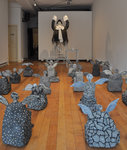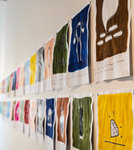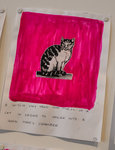To be fair, I don’t know much about good witches, and I’ve only learned about the scary ones through books, movies and a few bad dates over the years. That said, I’m always up for a …
Stay informed about your community and support local independent journalism.
Subscribe to The River Reporter today. click here
This item is available in full to subscribers.
Please log in to continue |




To be fair, I don’t know much about good witches, and I’ve only learned about the scary ones through books, movies and a few bad dates over the years. That said, I’m always up for a ride, so I strapped my dog to the old broomstick (does that make me a warlock?) and went back to Livingston Manor, NY this week to check out the Catskill Art Society’s (CAS) exhibit “Spectral Evidence,” now showing at the Laundry King through Saturday, June 19.
When I first walked in, I thought Nancy Bowen’s sculptures were of sea turtles wearing shoes, swimming under the tutelage of a hairy scarecrow as colorful flags waved in the imaginary breeze overhead. On closer examination, and with solid information provided by the gallery and a well-informed docent, I learned a thing or two about first impressions.
Turns out the “turtles” are actually Bowen’s interpretation of early American gravestone imagery of colonial witches; the “scarecrow” is meant to represent Samuel Sewall (1652-1730), a colonial politician who was responsible for sentencing the alleged witches to death by hanging. Finally, the “flags” are nothing of the kind, but rather “a suite of collages that accompany the 46 stanzas of Elizabeth Willis’s poem, ‘The Witch.’”
I peeked at the paperwork in the window and learned that Nancy Bowen is “an 11th-generation descendent of Sewall, who was the inspiration for this body of work,” and that she is a “mixed-media artist known for her eclectic mixtures of imagery and materials in both two and three dimensions.”
With the amazing docent (whose name I failed to ask, argh) at my side, I also learned that the figure sculpture of Samuel Sewall himself depicts a “rambunctious version of a hair shirt standing atop a scaffolding covered with gallows.”
If this all sounds interesting, that would be because it is, IMHO. It also illustrates the importance of museum and gallery docents, who donate their time and energy so that idiots like myself don’t walk away thinking about “sea turtles wearing shoes.” I learned that Samuel Sewall kept a diary from 1673 until a few months before his death in 1730 and that, “In 1692, he was one of nine judges appointed to the court in Salem, MA, charged with trying those who were accused of witchcraft.”
Apparently, Sewall had doubts about the veracity of the charges. After the trials, he believed that he was “blighted by punishments from God,” including more than a few sudden deaths in the family and the people of Massachusetts experiencing violence, “most notably [through] the declaration of the New England Dominion and [something else I knew nothing about] King Phillips War.”
Apparently, Sewall “saw this as a sign that witchcraft did not exist [and that] he had ruled on insubstantial evidence.” His diary records that, on January 14, 1697, he stood up in the meeting house he attended while his minister read out his confession of guilt, after which Sewall “put on a hair shirt, which he continued to wear [as penance] throughout his life.”
Dizzy with how mistaken (turtles, flags and all) I was, I took the advice given and checked out the art installation from all angles, snapping pictures. I found the sculpture of Sewall replete with miniature gallows hanging from his hair shirt particularly intriguing, and as I read the stanzas of Willis’s poem, I pondered what life must have been like in Salem circa 1700. Lines like, “A witch may take the form of a cat in order to sneak into a good man’s chamber” did not make me feel all warm and fuzzy, and I wondered momentarily if Sewall was wrong all along. Either way, I learned me a thing or two, which is one of the many reasons I love what I do.
Go. See. Get back to me at Jonathanfox@riverreporter.com with your own keen observations. My advice? Look twice... it might not be a sea turtle after all.
For more information on CAS and Nancy Bowen’s “Spectral Evidence” at the Laundry King, visit www.catskillartsociety.org.
Fun Fact: For those who live under a rock, the phrase “Are you a good witch or a bad witch?” is a line from “The Wizard of Oz,” a 1939 American musical fantasy film produced by Metro-Goldwyn-Mayer. Often seen as one of the greatest films of all time, it is the most commercially successful adaptation of L. Frank Baum’s 1900 children’s fantasy novel “The Wonderful Wizard of Oz.”
Comments
No comments on this item Please log in to comment by clicking here